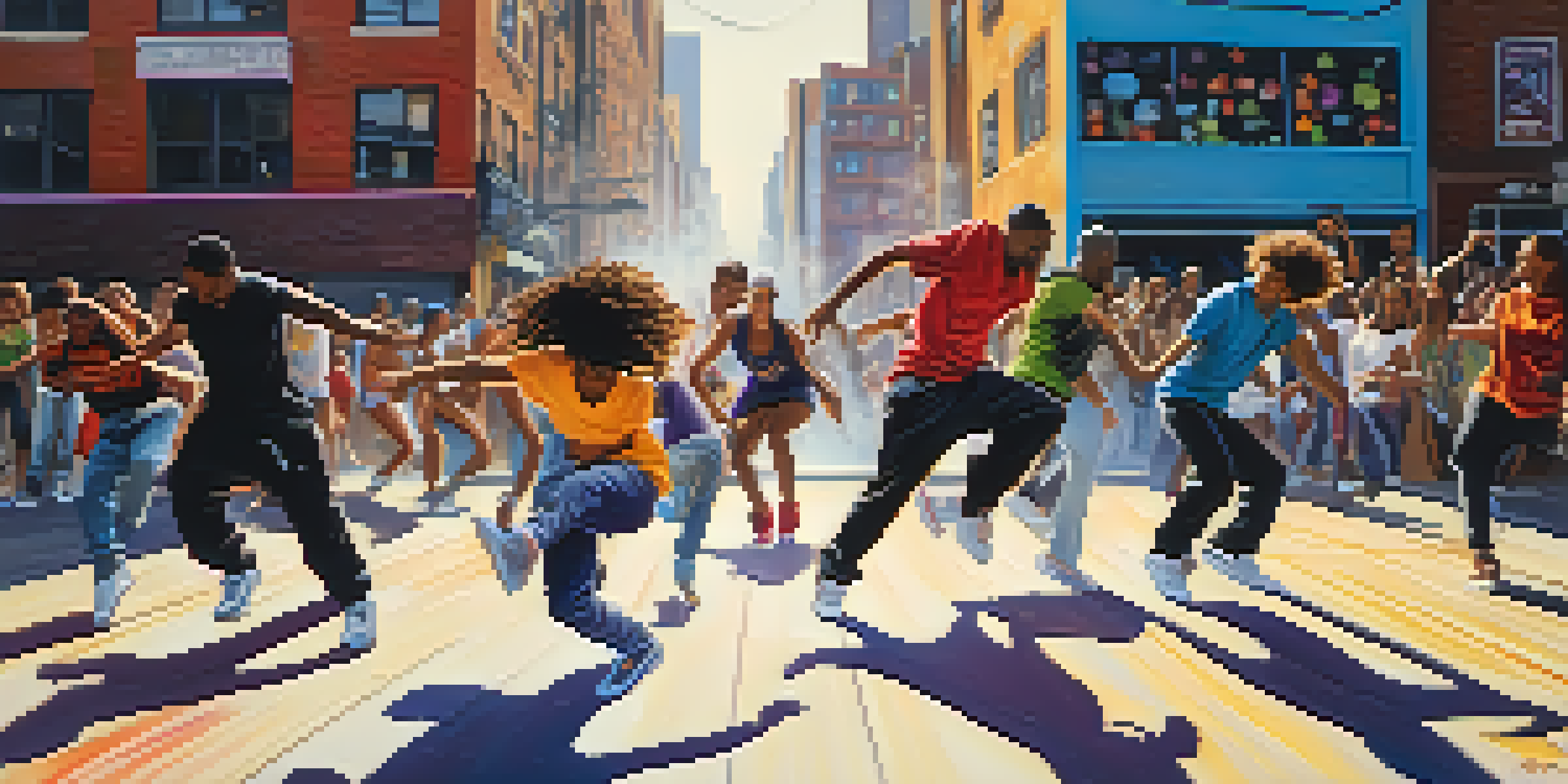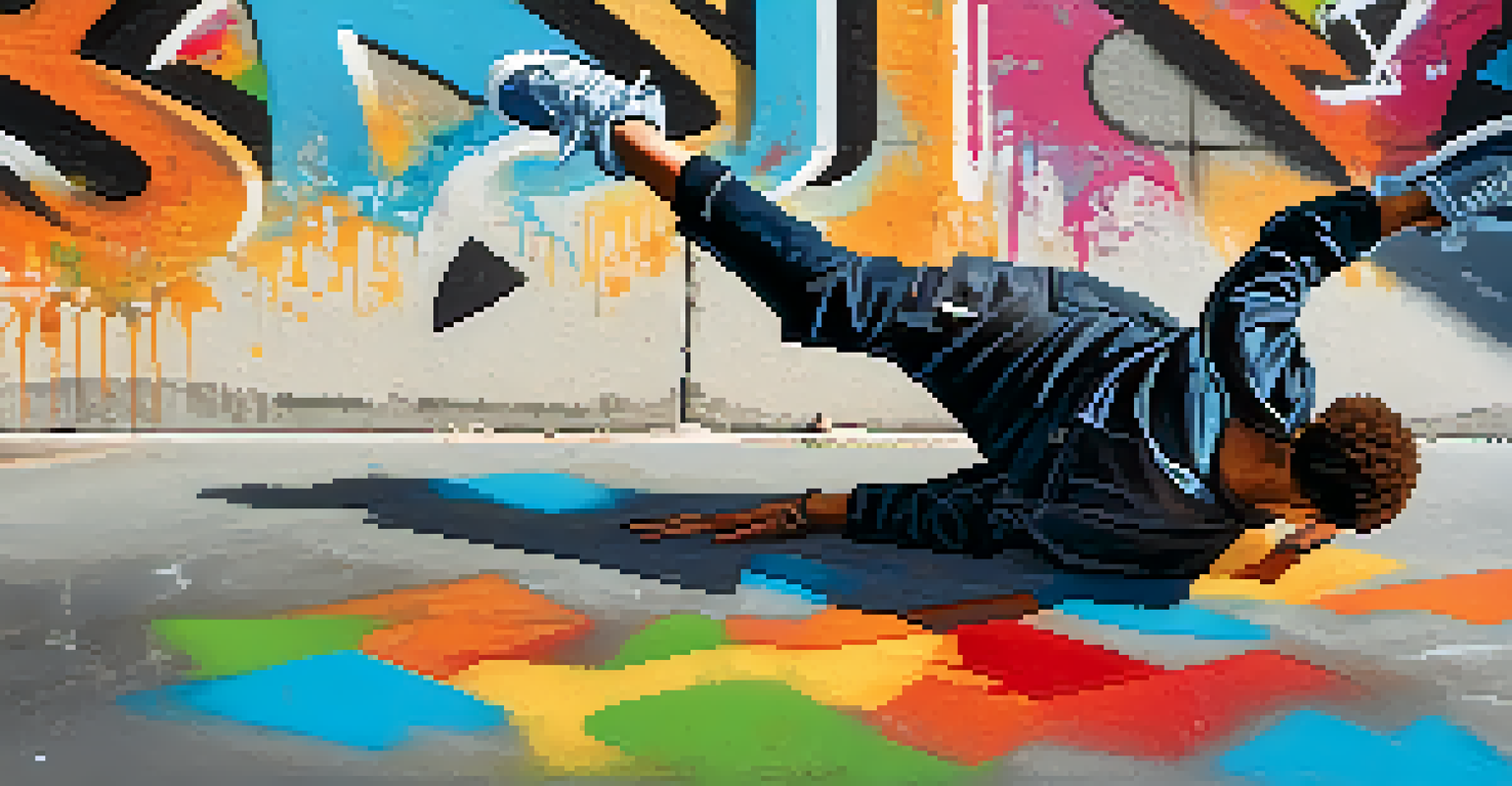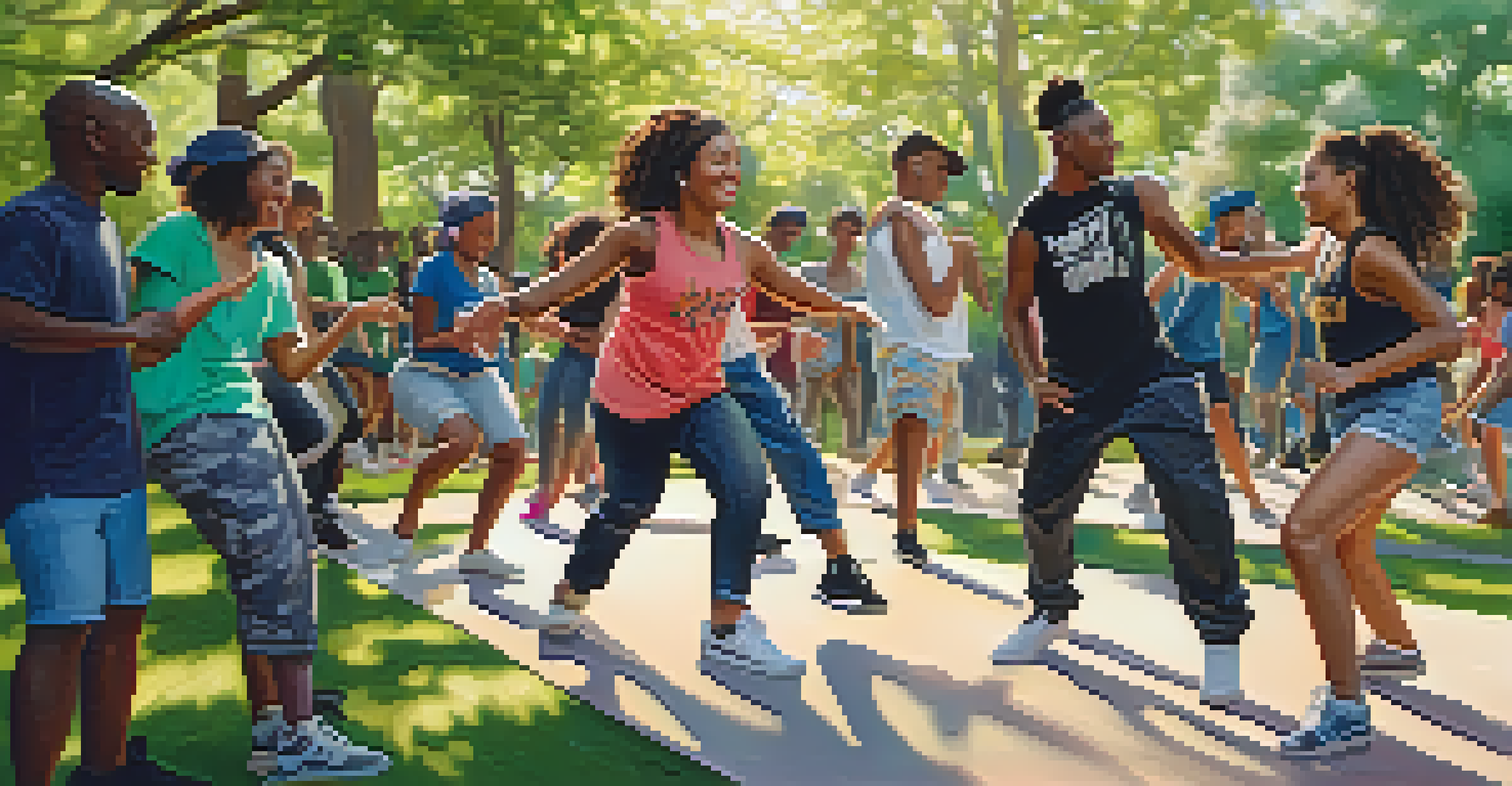Hip-Hop Dance: A Voice for Marginalized Communities

The Roots of Hip-Hop Dance in Marginalized Communities
Hip-hop dance originated in the streets, born from a blend of diverse cultures in marginalized neighborhoods. It provided a creative outlet for youth who felt sidelined by society, allowing them to express their struggles and aspirations. By channeling their energy into dance, these communities found a powerful way to advocate for their rights and share their stories.
Dance is the hidden language of the soul.
In places like the Bronx and Los Angeles, hip-hop dance emerged as a response to social and economic challenges, becoming a unifying force. This genre of dance is not just about the moves; it encapsulates the history, pain, and triumphs of communities often overlooked. The influence of hip-hop has grown, but its roots in these environments remain crucial to its identity.
As hip-hop dance continues to evolve, it retains a deep connection to its origins, reminding dancers and audiences alike of the social justice issues at its core. This form of expression allows artists to reclaim their narratives and challenge societal norms, making the dance floor a stage for activism.
Hip-Hop Dance as a Form of Protest
Hip-hop dance often serves as a platform for protest, providing a voice for marginalized individuals to convey their frustrations and hopes. Dancers use their bodies to make statements about injustice, inequality, and the need for change. This physical expression can resonate more deeply than words alone, creating a visceral connection with audiences.

For instance, dance battles and performances often address themes of resilience and empowerment. Choreographers incorporate movements that reflect social issues, transforming dance into a narrative of resistance and solidarity. This creative approach not only engages participants but also invites spectators to reflect on their roles in societal change.
Hip-Hop Dance as Social Protest
Hip-hop dance serves as a powerful platform for marginalized communities to express their struggles and advocate for social justice.
Moreover, hip-hop dance encourages community participation, uniting people from various backgrounds. By coming together to learn, practice, and perform, dancers foster a sense of belonging and collective strength. This communal aspect amplifies the message of protest, making it a powerful tool for social awareness.
Cultural Identity and Hip-Hop Dance
Hip-hop dance is a celebration of cultural identity, allowing marginalized communities to reclaim their heritage. Through dance, individuals express their unique backgrounds and experiences, creating a rich tapestry of movement that tells their stories. This connection to culture fosters pride and resilience, essential components in the fight against marginalization.
The arts are not a luxury; they are a necessity for a society to thrive.
Each dance style within hip-hop carries influences from various cultural traditions, further enriching the genre. From breakdancing to locking and popping, these styles reflect the histories and struggles of the communities that created them. As dancers honor their roots, they also educate others about the significance of their art form.
In this way, hip-hop dance becomes a bridge between cultures, fostering understanding and appreciation. When people engage with hip-hop, they are not just enjoying a performance; they are participating in a dialogue about identity, respect, and the celebration of diversity.
The Global Impact of Hip-Hop Dance
While hip-hop dance originated in the United States, its influence has spread globally, resonating with marginalized communities around the world. Dancers from various countries have embraced hip-hop as a means of self-expression, each adding their unique flavor to the genre. This global exchange enriches hip-hop culture and amplifies its message of resilience and empowerment.
In places like Brazil, South Africa, and Japan, hip-hop dance serves as a tool for social commentary, allowing dancers to address local issues while connecting with a broader audience. This cross-cultural dialogue reinforces the idea that struggles for social justice are shared across borders. Through dance, these communities find common ground and solidarity.
Cultural Identity Through Dance
Through hip-hop dance, individuals celebrate their cultural identities, reclaim their heritage, and foster pride within their communities.
The global reach of hip-hop dance also showcases the power of art in shaping societal narratives. As more dancers and choreographers take to the stage, they bring attention to critical issues, inspiring movements for change. This interconnectedness reinforces the notion that hip-hop dance is not just a performance but a vital voice for marginalized communities worldwide.
Education and Empowerment Through Hip-Hop Dance
Hip-hop dance is increasingly being incorporated into educational programs, serving as a tool for empowerment among marginalized youth. Dance classes provide a safe space for self-expression, allowing participants to explore their identities and emotions. This environment fosters creativity, confidence, and a sense of belonging.
Organizations that focus on dance education often emphasize the importance of storytelling through movement. By teaching hip-hop dance, they encourage students to share their experiences and perspectives, contributing to a greater understanding of social issues. This process not only enhances their dance skills but also promotes critical thinking and self-awareness.
As students gain confidence through their dance education, they often take on leadership roles in their communities. This empowerment can lead to increased advocacy for their rights and the rights of others, transforming dance into a catalyst for change. Ultimately, hip-hop dance education equips young people with the tools they need to navigate the complexities of their lives.
The Role of Social Media in Hip-Hop Dance Advocacy
In the digital age, social media plays a crucial role in amplifying the voices of hip-hop dancers and their messages. Platforms like Instagram and TikTok allow dancers to showcase their talent while sharing stories of struggle and resilience. This visibility can inspire others and create a sense of community among marginalized individuals worldwide.
Social media also provides a space for activism, where dancers can raise awareness about social issues and mobilize support. Viral dance challenges often incorporate themes of justice and equality, engaging a wider audience in important conversations. This blend of creativity and advocacy makes social media a powerful tool for change.
Global Reach and Impact
The influence of hip-hop dance has transcended borders, uniting dancers worldwide in a shared dialogue about resilience and empowerment.
Furthermore, social media allows for the democratization of dance, enabling anyone with access to share their work and perspectives. This shift challenges traditional notions of who gets to tell their story, empowering individuals from all backgrounds to participate in the conversation. In this way, hip-hop dance becomes a collective voice for change, transcending barriers.
The Future of Hip-Hop Dance and Marginalized Voices
As hip-hop dance continues to evolve, its role as a voice for marginalized communities remains vital. Dancers and choreographers are increasingly using their platforms to address pressing social issues, ensuring that the art form stays relevant and impactful. This commitment to advocacy keeps the spirit of hip-hop alive, grounded in its origins while looking toward the future.
The next generation of dancers is embracing this responsibility, blending traditional hip-hop styles with contemporary issues. This fusion creates a dynamic space for dialogue, where art meets activism. By prioritizing social justice in their work, these artists are shaping the future of hip-hop dance in profound ways.

Ultimately, the future of hip-hop dance is intertwined with the ongoing fight for equity and representation. As long as there are stories to tell and struggles to be addressed, hip-hop will remain a powerful vehicle for change, ensuring that marginalized voices are heard and celebrated.